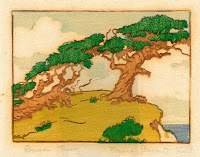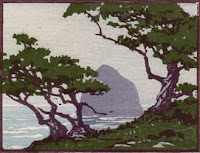American (Kansas) Printmakers.

 Both were active in their own studio's and in the privat studio of Mary Huntoon (1896-1970). She founded the Topeka Print Makers. They headquartered in her studio.
Both were active in their own studio's and in the privat studio of Mary Huntoon (1896-1970). She founded the Topeka Print Makers. They headquartered in her studio.  How good she was you can see in this small and deceivingly simple sketch of Brooklyn Bridge (below). I think she studied Arthur Wesly Dow's instructions on Notan very carefully.
How good she was you can see in this small and deceivingly simple sketch of Brooklyn Bridge (below). I think she studied Arthur Wesly Dow's instructions on Notan very carefully.

 In 1930 the Kansas Print Makers were founded. Their only woman co-founder was Norma Basset Hall (1884-1957) (above and below).
In 1930 the Kansas Print Makers were founded. Their only woman co-founder was Norma Basset Hall (1884-1957) (above and below). (two not everyday seen prints by Norma Basset-Hall)
Educated in the same Chicago's Art Institute (1915-graduated 1918) she and her husband travelled to Europe from 1925 -1927 visiting France, England and Scotland meeting in the end the noted etcher Ernest Lumsden and his wife: Mabel Royds (1874-1941). They stayed a year at the Lumsden-Royd's studying and absorbing the latest printing techniques with transparent water-based inks from Mabel Royds. Mabel a pioneer in woodblock printing and influenced by Henri Toulouse Lautrec. Lumsden already very famous for his etchings.  Ernest Lumsden: etching from the London scenes series.
Ernest Lumsden: etching from the London scenes series.
Mabel Royds was an appointed teacher in the Edinburgh School of Arts, together with colleague printer and head of the Applied Arts Department since 1910 John Edgar Platt (1886-1967). Platt was taught woodblock printing by Allan William Seaby (1867-1953). Seaby himself a pupil of Frank Morley Fletcher.
Frank Morley Fletcher (1866-1950) was director of the Edinburgh School of Art (1907-1923). Thus tying all important beginning of the XXth century Brittish woodblock printers together in Edinburgh. For further reading on these printers and the influences of Japanese printer Urushibara please follow the link to a recent post on Art and the Aesthete: http://www.clivechristy.com/2010/11/urushibara-and-frank-morley-fletcher.html
Fletcher later moved to California (US) and became director of the Santa Barbara Art School (1924-1930). Fletcher resigned as director in the spring of 1930 and eventually moved to Los Angeles where he continued to teach, paint, and exhibit. In the late 1930s his eyesight began to fail and his output became more sporadic. Wether he knew or met the Kansas Printers or Avis and Margaret I couldn't find evidence of.  Many important American printers became involved and even paying members (annual fee $ 1,00) of the Kansas Print Makers: among them Steng Wengenroth, Frances Gearhart, William Seltzer Rice, Walter Joseph Philipps and Bertha Jacques. To incourage blockprinting and to the benefit of selling their prints. In the after Great Depression years incouraging a new public to buy Real Art at reasonable prices. Margaret Whittemore was invited to join in an early stage. The Kansas Print Makers Group ended in 1965.
Many important American printers became involved and even paying members (annual fee $ 1,00) of the Kansas Print Makers: among them Steng Wengenroth, Frances Gearhart, William Seltzer Rice, Walter Joseph Philipps and Bertha Jacques. To incourage blockprinting and to the benefit of selling their prints. In the after Great Depression years incouraging a new public to buy Real Art at reasonable prices. Margaret Whittemore was invited to join in an early stage. The Kansas Print Makers Group ended in 1965.
Continuing the trail and history even further back: Frank Morley Fletcher was (also) taught by Fernand Cormond (1845-1924), most important historical painter of France, attending the Cormond school in Paris in1888.

Class of 1885 of Fernand Cormond's school in Paris.
Before him Henri Toulouse-Lautrec and Vincent van Gogh took classes there. And there Frank Morley Fletcher, Godfather of all English woodblock printers, became interested in woodblock printing.
In 1889 the World Exhibition took place in Paris. Some 32.000.000 (!) visitors came to Paris over 6.000.000 by train alone. Among them most heads of European states and many contemporary important artists. The list is long. Whistler was there, Gauguin, van Gogh, Edvard Munch, Buffalo Bill Cody and many many others visited the pavillions
 The World Fair was held on the grounds near the river Seine were the newly constructed Eifel Tower served as an entrance symbol, and again later in 1900. In 1909 all buildings were demolished and the grounds redesigned into the park as it now exists.
The World Fair was held on the grounds near the river Seine were the newly constructed Eifel Tower served as an entrance symbol, and again later in 1900. In 1909 all buildings were demolished and the grounds redesigned into the park as it now exists.
Auguste Lepère (1849-1918) Exposition Internationale 1889 .

(Exactly the same spot, see the perspective, but the party over and the crowds gone)
NEXT:
To be continued soon with postings on the solo prints of both ladies: Margaret Whittemore and Avis Chitwood.





































